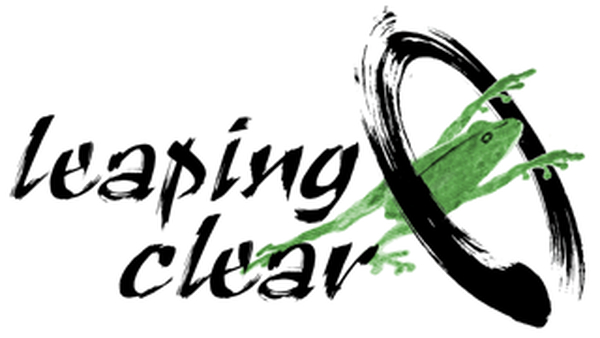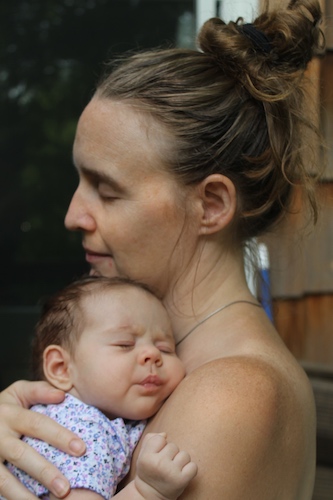Jesse Curran
The Only Work
Sit comfortably. Use a blanket or bolster to relax your hips. As you inhale, lift your chest. As you exhale, release your shoulder blades, let them glide down your back. Ease into your seat. Close your eyes or lower your gaze. Begin to draw your attention inward.
Know this: the breath is everything, all there is. It enables you. It fills you and fuels you. It pacifies and pleasures. It is the means of working with and within, and of seeing, what is.
Know this: the breath is the essential metaphor, and is, in turn, full of metaphor. Let the breath be an ocean, a ribbon, waves crashing on the shore. See it as a figure eight, entering through the nose and circling around through the belly before it releases back out again. An infinite breath. Use it to welcome spring and release winter. Use it as a vehicle of transformation. Take in white light, surrender black smoke. Breathe in the present, exhale the past.
Its etymology is enticing, suggestive of its core quality. The Latin spirare. The spirit. And so, those who follow the breath, follow the spirit.
To aspire, to conspire, to perspire, to transpire. To breathe on, with, out, and through.
Breathe in. Slight pause at the top inhale. Full breath out.
I teach college freshman hatha yoga. When they come, on the first day of class, I realize that some are being taught to breathe for the first time. Novice breathers who have been breathing for nineteen years. We start at the beginning. First, consider inhaling through the nose, out through the mouth. A gentle pause between each breath. Then we work toward breathing in and out through the nose. After a few weeks, we move toward the great ujjayi, the ocean breath. The Darth Vader breath. The breath that saved me. That saves me. Breath by breath. Day by day. My sense of this practice teaches one lesson: the great gift of the asana is the ways in which they allow us opportunity to practice our breath. It’s not yoga without the breath.
I too did not know, was never taught. I learned about everything as a student. I dove headfirst into the intellectual feast offered by the liberal arts. I read all of Shakespeare, Keats, Chekhov, Woolf, and Rilke. I studied Ancient Philosophy and World History. But I was never taught how to breathe. This skill was something saved for the swimmers and cross country kids. Not for me, the Literature PhD. Not until I almost collapsed with the pressure I had put on myself to perfect myself. Not until I found restorative yoga and a teacher who taught me to breathe in what nourishes and to release what no longer serves me. It was only then that I began to understand the invisible landscape of poetry—the force of its animation. The place, dear Rilke, where rhythmically we come to be:
Breath, you invisible poem!
Pure, continuous exchange
With all that is, flow and counterflow
Where rhythmically I come to be[1]
Give the breath shape. Experiment with retention. Begin to coordinate it with your motion. Inhale, sun breath, arms and up and overhead. Exhale, hinge from the hip, forward fold. Inhale to open heart, exhale to bow it toward the earth. Inhale as we lift. Exhale as we release.
Alternate nostril breathing. Tiered breath. Counting breath. Square breath. Bastrika and Khalbhati. Nadi Sudi. The great history of pranayama. Patanjali’s Sutras. The fourth Limb of Yoga. The heart of the practice.
As the movement patterns of each breath—inhalation, exhalation, lull—are observed as to duration, number, and area of focus, breath becomes spacious and subtle.
As realization dawns, the distinction between breathing in and out falls away.
Then the veil lifts from the mind’s luminosity.
And the mind is now fit for concentration.[2]
The mind will move away from the breath. Draw it back. No breath can be saved, held, fixed. The breath is fluid, ever-changing. Both voluntary, involuntary. The great river of continuity. Dive into it. Flow forward.
The poetics of breath is a subject of both my scholarly research and personal fascination. Whitman is the vast breather, the deep drinker. And Dickinson, the acutely conscious breather, the one who watches: the constriction, the tightening, the silence in the room. Everything we might learn about their projects, we can witness in how they represent breath. His reaching outward, her turning inward. His audacious expansion, her discerning dilation.
Whitman:
My respiration and inspiration, the beating of my heart, the passing of blood and air through my lungs.
Returning is a different route
The Spirit could not show
For breathing is the only work
To be enacted now.
The breath is encompassing: the reach, the arrival, the departure. It is inescapable, circular, the means itself of connection. And so, it also lies the center of sex, in moments when we might merge our breath with the breath of another. In unison. Drinking in one another. Intimate beyond all else. The breath brings us in constant contact; the breath melts the edges, and is, as the Ancient Greeks knew, the essence of touch.
Empedokles’ celebrated doctrine of emanations, for example, maintains that everything in the universe is perpetually inhaling and exhaling small particles called aporrhoai in a constant stream…. The aporrhoai are mediators of perception which allow everything in the universe to be potentially ‘in touch’ with everything else…. Breath is everywhere. There are no edges. The breath of desire is Eros.[3]
And perhaps such continuity between beings is no where more apparent than during pregnancy. A time of shorter breath due to increased blood volume and the constant need for oxygenation. Breathe into the baby, we tell the prenatal yogis.
There were days during my first pregnancy when I went to yoga class and just sat on my mat. I took my own advice: breathe into the baby. It was all the work I needed. It was then that I was most grateful for my practice. And though I faithfully meditated for about a decade before my children, it was only after their births that I came into a comfort with the practice, sought it, surrendered to it, appreciating the hush, the doing nothing, the rise and fall or each breath.
My son is two months old as I write, peacefully asleep on the couch. I watch his belly rise with the inhale, and fall with the exhale. The perfect belly breath. The breath most adults have lost—a breath I lost. A breath our culture teaches us to banish, as we hold in the gut and attempt to slip into an ever-slimming pair of jeans. It is a breath the baby reminds me to practice. A breath to sustain one through the trials of toddler tantrums and the months of sleep deprivation. When I nurse him, I can see his fontanel rising and falling in a sustaining rhythm, it’s uncanny, but also a reminder for me to try and do the same.
Since becoming a mother, lassoed to the daily work of keeping the children fed and the house in order, there are less hours for me on my mat. I don’t see any ecstatic mountaintops in my future, any doors of perception breaking open, nor much time for meditation retreats or advanced yoga teacher trainings. Even quiet, something I used to bathe in all morning, seems a luxury from a past time and a lost place. My attention darts from child to child, from need to need, from dirty diaper to dirty diaper. But with each breath, I can surrender to their laughter, their resolve to play through even the most dismal days. I can be with them for a moment, and then another. And so on. I can enter the river of our shared being.
There is this. Deep inhale. Full exhale. There is this breath, this ceaseless flowing under the surface of every thought, the pulsing force of every feeling. When I take my baby in my arms, skin to skin, and I breathe into him, I enter into all that is. With my inhale I take in new beginnings and with my exhale, I send him what I seek for myself: the ability to let go what does not serve and to make one’s pain into a sinuous and spacious shape. If I have faith in anything, it is this.
This is my practice, my passion, my still point, my sense of space. This, dear Dickinson, as you well knew, is the only work. Work, sweet work, to be enacted now.
Breathe in, filling belly, then flooding the chest. Exhale and release chest, then belly.
And one more time, at your own pace, in a way that nourishes you.
[1] Anita Barrows and Joanna Macy, Praise of Mortality: Selections from Rainer Maria Rilke's Duino Elegies and Sonnets to Orpheus (New York: Riverhead Books, 2005).
[2] Chip Hartranft, The Yoga Sutras of Patanjali (Boston: Shambhala, 2005).
[3] Anne Carson, Eros The Bittersweet (Normal, IL: Dalkey Archive, 1998).
Jesse Curran
I have been faithfully practicing (and teaching) hatha yoga for about a decade now, and as my practice has evolved and deepened, I have become more convinced that the breath is the most vital component of yoga and is also a means of understanding poetic process and expression. The breath is intimate and expansive; biological and spiritual; ever-present and ephemeral. Yoking both metaphor and rhythm, it can be choreographed to open space in both mind and body and to create narratives of both sustenance and surrender. The breath is, as Walt Whitman writes, "my respiration and inspiration," the heart of my practice, what I return to, the work I can do, the gift I've been given.
Jesse Curran holds a PhD in English from Stony Brook University and is an educator, scholar, gardener, and yoga instructor. Her poetry and essays have been published in numerous journals including, The Emily Dickinson Journal, Green Humanities, Blueline, The Fourth River, About Place, Lime Hawk, Spillway, and Ruminate. She is the mother of two bright stars, Leona and Valentine, and lives in Northport, NY.
More on Jesse Curran’s work can be found on our Links page.

